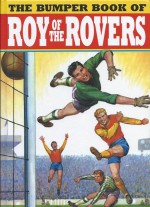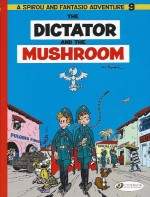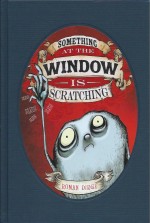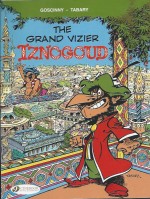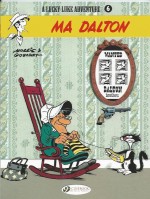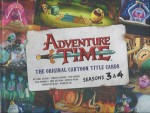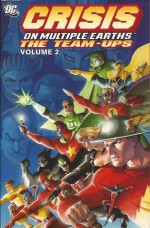
By John Broome, Gardner Fox, Mike Friedrich, Neal Adams, Murphy Anderson, Gil Kane, Carmine Infantino & various (DC Comics)
ISBN: 978-1-4012-1228-5
Super-Editor Julius Schwartz ushered in the Silver Age of American Comics with his Showcase successes Flash, Adam Strange and Green Lantern, directly leading to the Justice League of America which in turn inspired Fantastic Four and the whole Marvel Empire and changed the way comics were made and read…
Whereas the 1940s were about magic and macho, the Silver Age polished everything with a thick veneer of SCIENCE and a wave of implausible rationalistic concepts quickly filtered into the dawning mass-consciousness of a generation of baby-boomer kids.
The most intriguing and rewarding was, of course, the notion of parallel worlds…
It all began, naturally enough, in The Flash, flagship title of the Silver Age Revolution. After ushering in the triumphant return of the costumed superhero concept, the Crimson Comet, with key writers Gardner Fox and John Broome at the reins, set an unbelievably high standard for superhero adventure in sharp, witty tales of technology and imagination, illustrated with captivating style and clean simplicity by Carmine Infantino.
Fox didn’t write many Flash scripts at this time, but those few he did were all dynamite; none more so than the full-length epic which literally changed the scope of American comics forever.
‘Flash of Two Worlds’ (Flash #123, September 1961) introduced the theory of alternate Earths to the continuity which grew by careful extension into a multiversal structure comprising Infinite Earths. Once established as a cornerstone of a newly integrated DCU through a wealth of team-ups and escalating succession of cosmos-shaking crossover sagas, a glorious pattern was set which would, after joyous decades, eventually culminate in a spectacular Crisis on Infinite Earths…
During a benefit gig Flash (police scientist Barry Allen) accidentally slips into another dimension where he finds the comic-book hero upon whom he based his own superhero identity actually exists. Every adventure he had absorbed as an eager child was grim reality to Jay Garrick and his comrades on the controversially designated “Earth-2â€. Locating his idol, Barry convinced the elder to come out of retirement just as three Golden Age villains were making their own wicked comeback…
The floodgates were opened, as over the months that followed many Earth-1 stalwarts met their counterparts either in annual collaborations in the pages of Justice League of America or in their own series. Schwartz even had a game go at reviving a cadre of the older titans in their own titles. Public approval was decidedly vocal and he used DC’s try-out magazines to take the next step: stories set on Earth-2 exclusively featuring Golden Age characters.
Showcase #55 and 56 saw Doctor Fate and Hourman as a dynamic duo battling Solomon Grundy and the Psycho-Pirate and, still searching for an concept that would support its own series, Schwartz, Fox and Murphy Anderson debuted the team of Starman and Black Canary in The Brave and the Bold #61 (September-October 1965); the first of two stunning sagas which somehow led to nothing…
All those stories can be found in the previous edition (Crisis on Multiple Earths: the Team-Ups volume 1) whilst this second splendid collection – chronologically re-presenting The Atom #29 & 36, Flash #170 & 173, Green Lantern #45 & 52 and The Spectre #3 , cumulatively spanning October/November 1965 to April/May 1968 – opens with Brave & Bold #62 and a second Starman/Black Canary case wherein the resurgent champions ferociously face off against husband-and-wife criminals Huntress and Sportsmaster who had been stalking superheroes for kicks and profit. By the time Feline Fury Wildcat became their victim our heroes were on the case and ready for anything…
This compelling thriller was originally augmented by a text feature biography of the original Starman and that is reprinted here before Earth-2 Emerald Gladiator Alan Scott reunites with “our†Hal Jordan (Green Lantern #45, June 1966, by Broome, Gil Kane & Sid Greene) to thwart ‘Prince Peril’s Power Play’ as Scott’s comedy foil Doiby Dickles was romanced by an alien princess. The only fly in their ointment was a gigantic and ambitious space warrior who needed her to cement his own plans for conquest, but judicious use of green energies soon taught him that nobody likes a pushy tyrant…
Earth-2’s Tiny Titan was Al Pratt, a short man with super-strength, whilst we had size changing physicist Ray Palmer. When they met in Atom #27 (February/March 1967, by Fox, Kane & Greene) it was for an all-out cataclysmic clash between the Mighty Mites and one of the most dangerous villains of DC’s Golden Age in ‘The Thinker’s Earth-Shaking Robberies!’
With Green Lantern #52 (Broome & Kane, April 1967) Alan Scott and Doiby popped over from Earth-2 to aid Hal against the scurrilous return of his arch nemesis Sinestro in camp-crazed and frankly rather peculiar fight-frenzied fist-fest ‘Our Mastermind, the Car!’ after which a brace of Scarlet Speedsters at long last reunited in Flash #170 to face the ‘The See-Nothing Spells of Abra Kadabra!’ (May 1967 by Broome, Infantino & Greene) which found the Vizier of Velocity hexed by the cunning conjuror and rendered unable to detect the villain’s actions or presence.
Sadly for the sinister spellbinder, Jay Garrick was visiting and called on the services of JSA pals Doctors Fate and Mid-Nite to counteract the wicked wizard’s wiles…
Promptly following, Flash #173 (September 1967 by Broome, Infantino & Greene again) featured a titanic team-up as Barry, Wally “Kid Flash†West and Jay were sequentially shanghaied to another galaxy as putative prey for alien hunter Golden Man in ‘Doomward Flight of the Flashes!’
However, the sneaky script slowly revealed devilish layers of intrigue and his Andromedan super-safari concealed a far more arcane purpose for the three speedy pawns, before the wayward wanderers finally fought free and found their way home again…
Eventually Schwartz finally achieved the ambition of launching a Golden Age hero into his own title; sadly just as the superhero bubble was bursting and supernatural stories were again on the rise…
After three Showcase appearances and many guest-shots, The Spectre won his own book at the end of 1967. From #3 (March/April 1968) comes this all Earth-2 team-up by neophyte scripter Mike Friedrich and artistic iconoclast Neal Adams which exposed the ‘Menace of the Mystic Mastermind’ wherein pugilistic paragon Wildcat confronted head-on the inevitable prospect of age and infirmity even as an inconceivable force from another universe possessed petty thug Sad Jack Dold and turned him into a nigh-unstoppable force of cosmic chaos…
This fabulous peek into forgotten worlds and times concludes with one of the very best team-up tales of the Silver Age as the Earth-2 Atom returns in ‘Duel Between the Dual Atoms’ (April/May 1968, by Fox, Kane & Greene) wherein a radiation plague plays hob with victim’s ages on both worlds simultaneously. Sadly the deadly situation also turns normally hyper-rational Ray Palmer into an enraged maniac and almost more than his aging counterpart can handle…
Still irresistible and compellingly beautiful after all these years, the stories collected here shaped the American comics industry for decades and are still influencing not only today’s funnybooks but also the wave animated shows, movies and TV series which grew from them. These are tales and this is a book you simply must have.
© 1965-1968, 2007 DC Comics. All Rights Reserved.

